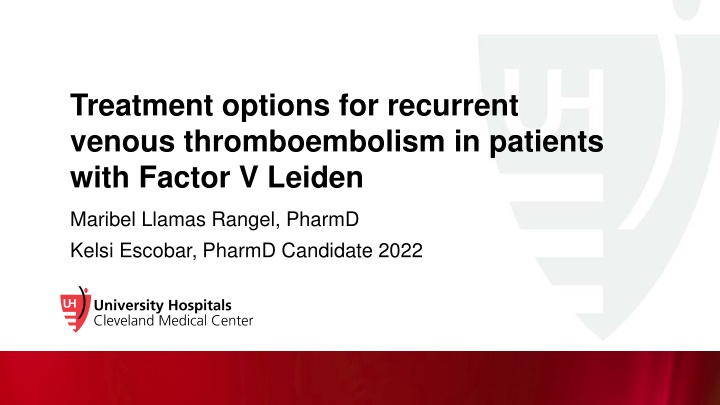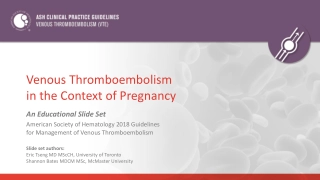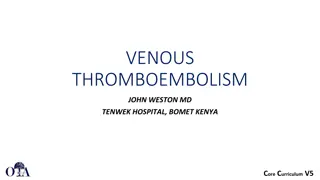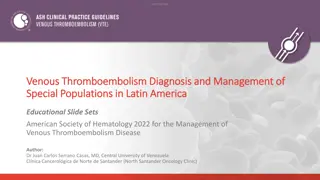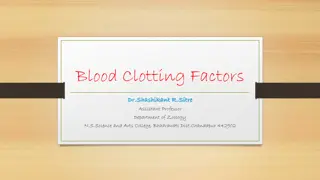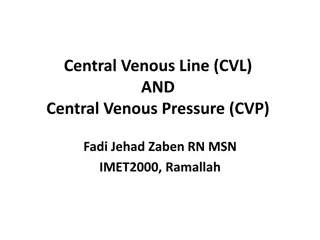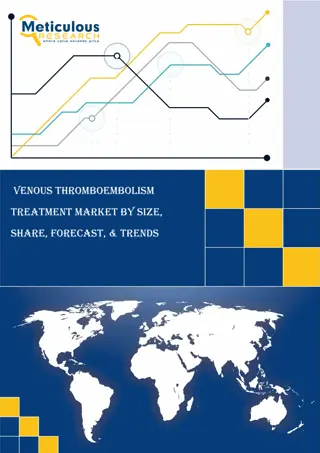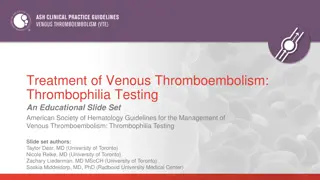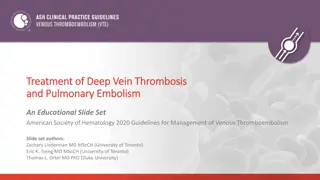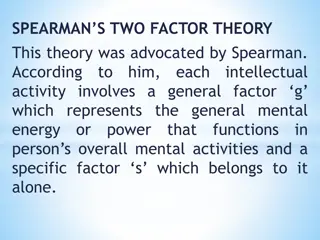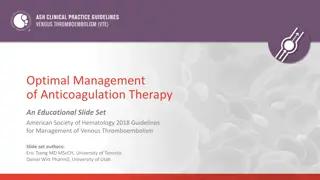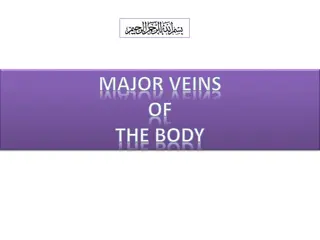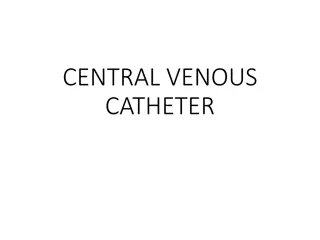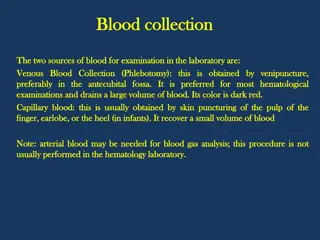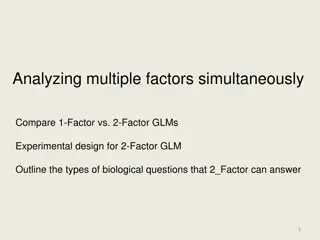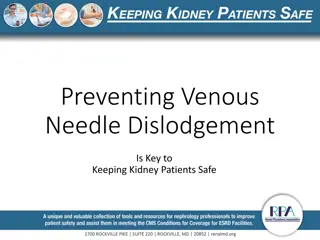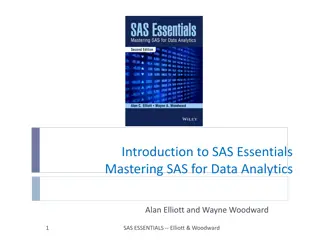Treatment Strategies for Recurrent Venous Thromboembolism in Factor V Leiden Patients
This presentation discusses the treatment options for recurrent venous thromboembolism in patients with Factor V Leiden mutation. It explores the pathophysiology, epidemiology, and diagnosis criteria for Factor V Leiden, reviews failed anticoagulation history, and suggests outpatient anticoagulation plans based on literature. A patient case of a 43-year-old female with Factor V Leiden, extensive VTE history, and challenging compliance issues is presented.
Uploaded on Sep 20, 2024 | 1 Views
Download Presentation

Please find below an Image/Link to download the presentation.
The content on the website is provided AS IS for your information and personal use only. It may not be sold, licensed, or shared on other websites without obtaining consent from the author.If you encounter any issues during the download, it is possible that the publisher has removed the file from their server.
You are allowed to download the files provided on this website for personal or commercial use, subject to the condition that they are used lawfully. All files are the property of their respective owners.
The content on the website is provided AS IS for your information and personal use only. It may not be sold, licensed, or shared on other websites without obtaining consent from the author.
E N D
Presentation Transcript
Treatment options for recurrent venous thromboembolism in patients with Factor V Leiden Maribel Llamas Rangel, PharmD Kelsi Escobar, PharmD Candidate 2022
Objectives Review the pathophysiology, epidemiology and diagnosis criteria for Factor V Leiden (FVL) Identify treatment strategies for Factor V Leiden associated venous thromboembolisms (VTE) Apply literature to patient case and discuss outpatient anticoagulation plan 2
Patient Introduction CS is a 43-year-old female who presented to UH Lake West emergency department with SOB notification of O2 desaturations from her apple watch Began experiencing SOB that was worse on exertion several days prior PMH o FH o o o o Heterozygous Factor V Leiden (diagnosed in 2002) Previous PE/DVT Previous smoker Insomnia ADHD Major depressive disorder Mother: Factor V Leiden Grandmother: Factor V Leiden Maternal uncle: Factor V Leiden 2/6 cousins: Factor V Leiden o o o o o 3
VTE History Extensive PE and DVT history (first one ~ 2004) Reports one per year Has failed anticoagulation rivaroxaban & apixaban (states compliant) Warfarin did not work for her as she has 6 kids and she can t comply with INR testing 4
Patient Introduction Home Medications o Enoxaparin 100 mg subQ BID o Atomoxetine 100 mg QAM o Dextroamphetamine 30 mg BID o Pantoprazole 40 mg daily o Fluoxetine 40 mg QHS o Seroquel 400 mg QHS o Zolpidem 10 mg daily Allergies IV contrast (severe pain) o Prochlorperazine (rash) o Sumatriptan (nausea) o Tramadol (nausea) o Influenza vaccine (rash) o Patient reports she had been taking it ONCE daily 5
Laboratory Findings 12.3 HR: 106 beats/min RR: 24 breaths/min SpO2: 88% on RA BP: 128/100 mmHg Troponin: 20 ng/mL Lactate: 2.1 mmol/L Weight: 103 kg o 7.6 267 o 36.6 o o o 138 109 12 138 o 17 *5 0.81 o * Mildly hemolyzed 6
Diagnostic Imaging Imaging CT PE Results Submassive saddle pulmonary embolus o Main pulmonary artery o Left upper/lower o Right pulmonary artery Acute DVT in left common femoral vein DVT U/S lower extremity 7
Initial Management Pulmonary Embolus Response Team (PERT) call was activated, and patient was transferred to CMC ICU for further management CS received 1L of NS and was initiated on a high intensity heparin drip Loading Dose 80 units/kg Maintenance Dose 18 units/kg/hour Therapeutic Goal Heparin Assay (UFH) 0.3-0.7 High Intensity 8
Factor V Leiden Pathophysiology, Diagnosis, and Treatment Options 9
Factor V Leiden (FVL) Autosomal dominant condition Prevalence within the United States Most common form of inherited thrombophilia White Americans 5.2% Mutation in F5 gene Removes the cleavage site on factor V and Va for active protein C (APC) Factor Va is inactivated at a 10-fold slower rate than normal Hispanic Americans 2.2% Native Americans 1.25% African Americans 1.2% Asian Americans 0.45% 10 Kujovich JL. Genet Med. 2011;13(1):1-16.
FVL Pathophysiology 11 Kujovich JL. Genet Med. 2011;13(1):1-16.
Clinical Manifestations VTE is the primary clinical manifestation of FVL Many individuals with a FVL allele will never develop thrombosis The mutation is found in 25% of patients with a first idiopathic VTE and up to 40 50% of those with recurrent VTE or an estrogen- related thrombosis 12 Kujovich JL. Genet Med. 2011;13(1):1-16.
FVL Types Heterozygous Associated with ~ 3 to 8-fold risk of VTE Homozygous Associated with ~ 80-fold risk of VTE Pseudo-homozygotes Heterozygous for both FVL plus additional mutation causing Factor V deficiency Pseudo-wild type Normal APC resistance phenotype, but heterozygous with null factor V or FVL mutations on the same allele 13 Kujovich JL. Genet Med. 2011;13(1):1-16.
Estimated risk of thrombotic complications 14 Kujovich JL. Genet Med. 2011;13(1):1-16.
Clinical Diagnosis Indications for testing No specific features 1st unprovoked VTE at any age Suspect in individuals with history (Hx) of VTE Hx recurrent VTE VTE at unusual sites (cerebral, mesenteric, hepatic, portal veins) Diagnostic tests: APC resistance assay DNA analysis of F5 gene VTE during pregnancy VTE associated with estrogen contraception 1st VTE + first-degree family member with VTE before age of 50 15 Kujovich JL. Genet Med. 2011;13(1):1-16.
APC Resistance Assay An activated partial thromboplastin time (aPTT) is performed on the individual's plasma in the presence and absence of a standardized amount of exogenous APC The two results are expressed as a ratio (aPTT + APC/aPTT APC) APC-resistant phenotype is characterized by minimal prolongation of the aPTT in response to APC This test has a sensitivity and specificity for Factor V Leiden approaching 100% 16 Kujovich JL. Genet Med. 2011;13(1):1-16.
DNA-based testing Recommended in individuals with: Antiphospholipid syndrome Prolonged baseline aPTT Positive APC assay Confirmation of FVL Distinguish specific genotype Very low or borderline APC resistance assay values Family history of FVL 17 Kujovich JL. Genet Med. 2011;13(1):1-16.
Risk factors VTE in heterozygous FVL Obesity Oral contraceptives Hormone replacement therapy Air travel Minor injury Malignancy Central venous catheters Pregnancy 18 Kujovich JL. Genet Med. 2011;13(1):1-16.
Estimated Prevalence 19 Kujovich JL. Genet Med. 2011;13(1):1-16.
Treatment There is no current recommendation for primary prevention of VTE in patients with FVL The American College of Chest Physicians recommend anticoagulation in provoked and unprovoked DVT or PE Acute management: LMWH or UFH + warfarin (INR goal 2.5) Chronic management: Based on risk for recurrence and bleeding 20
Dose Onset T Monitoring UFH 80 units/kg bolus followed by a continuous infusion of 18 units/kg/hour IV: immediate 1-2 hours (affected by obesity, renal function, PE, infection) Anti-factor Xa aPTT SubQ: ~20-30 minutes LMWH 1 mg/kg Q12H or 1.5 mg/kg Q24H Peak effect: 3-5 hours Plasma: 2-4x longer than UFH Anti-factor Xa aPTT Anti-Xa: 4.5-7 hours Fondaparinux <50 kg: 5 mg daily 50-100 kg: 7.5 mg once daily >100 kg: 10 mg daily Time to peak: ~2-3 hours 17-21 hours (longer in renal dysfunction and elderly) --- Warfarin Dependent on INR Initial: 24-72 hours Full: 5-7 days 20-60 hours, variable INR 21 Lexi-Drugs. Lexicomp.
Dose Onset T Monitoring Rivaroxaban 15 mg BID x21 days then 20 mg once daily Peak: 2-4 hours Adult: 5-9 hours Elderly: 11-13 hours Apixaban 10 mg BID x 7 days then 5 mg BID 3-4 hours ~12 hours Renal function, S/sx of bleeding or thrombus Edoxaban >60 kg: 60 mg daily 60 kg: 30 mg daily Peak: 1-2 hours 10-14 hours Dabigatran 150 mg BID Peak, fasting: 1 hour (delayed 2 hours by food) Adults: 12-17 hours Elderly: 14-17 hours Mild-Mod Renal: 15-18 hours Severe renal: 28 hours 22 Lexi-Drugs. Lexicomp.
Primary Literature Title Direct Oral Anticoagulants in Patients with Inherited Thrombophilia and Venous Thromboembolism: A Prospective Cohort Study Design Single center cohort study conducted January 2014 December 2019 Population/ intervention 275/597 (46.1%) treated with DOACs 61.1% received rivaroxaban 118/275 had FVL diagnosis 322/597 (53.9%) treated with heparin/VKAs 77.3% received warfarin 132/322 had FVL diagnosis Results VTE recurrence incidence: 3/275 in DOAC vs. 6/322 in Heparin/VKA Bleeding events: 28/275 in DOAC vs. 16/322 in Heparin/VKA Conclusion DOACs showed similar efficacy when compared to heparin/VKA in treatment of VTE, however, were associated with increase bleeding episodes. 23
Primary Literature Title Fondaparinux for the Treatment of Recurrent Venous Thromboembolism During Low Molecular Weight Heparin Therapy: A Retrospective Case Series Design Restrospective review of patients with recurrent thromboembolism Population/ intervention n = 13 3 sickle cell disease, 3 antiphospholipid syndrome, 3 cancer, 1 May Thurner syndrome, 3 inherited thrombophilia (FVL) All had failed enoxaparin Fondaparinux was prescribed at 7.5 mg daily or 10 mg daily VTE recurrence incidence: 4/13 patients had recurrent thromboembolic episodes Response rate ~ 69% No bleeding complications or deaths reported Fondaparinux may have efficacy in the treatment of recurrent VTE that has progressed on LMWH Results Conclusion 24
Revisiting CS Patient assessed for interventional therapy Ambulation test monitor for tachycardia/desaturation Vascular medicine recommended testing for lupus Due to patient presentation and recurrence of VTE Lake West studies CT PE: significant PE burden in the PA with a dilated RV Duplex scan: chronic changes in the LLE ECHO: RV thrombus 25
Revisiting CS Tolerated two laps around the unit with no desaturation or increase in heart rate Patient underwent mechanical thrombectomy 50% thrombus burden removed Cardiac surgery consulted for surgical thrombectomy patient decided against surgical intervention 26
Discussion What would your anticoagulation plan be for CS? 27
Treatment Options for CS Rivaroxaban Had VTE while compliant Apixaban Had VTE while compliant Edoxaban Once daily could be a good option Dabigatran Medication is dosed twice daily patient has poor compliance UFH SubQ: Initial: 333 units/kg, followed by 250 units/kg every 12 hours Warfarin Poor compliance with INR requirements LMWH BID versus once daily? Fondaparinux Once daily could be a good option 28
Discharge Patient was ultimately treated with UFH drip while inpatient Transitioned to fondaparinux What would be her dose? How do we transition? Would you have recommended something differently? 29
Conclusion Patients with FVL are at an increased risk of developing initial and recurrent venous thromboembolisms Current guideline recommendations are limited for anticoagulation regimens in this patient population Treatment strategies should be tailored to patient lifestyle to achieve therapeutic success 30
References Kujovich JL. Factor V Leiden thrombophilia. Genet Med. 2011;13(1):1-16. doi:10.1097/GIM.0b013e3181faa0f2 Lexi-Drugs. Lexicomp. Wolters Kluwer. Hudson, Oh. Available at https://online.lexi.com. Accessed November 18, 2021. https://www.ahajournals.org/doi/full/10.1161/01.cir.0000068167.08920.f 1 https://www.uspharmacist.com/article/review-of-factor-v-leiden- thrombophilia 31
